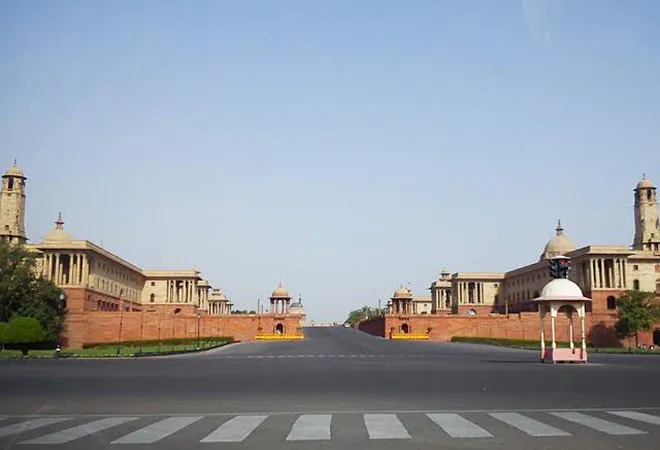Delhi has yet to overcome its Raj inheritance. The capital exudes the complacence of satiated imperialism, decades after the rest of the country has been democratized.
Two particularly deep-seated Raj dogmas plague Delhi. First, that India has an entitlement to lead the world and second, that our long-term foe is China and not the United States.
No country has succeeded by simply conjuring up a divine right to rule. Our place in the world shall be determined, by what we can do for the rest of the world – in the supply of merchandise goods and services; capital and public goods like world peace, climate security and a sturdy moral compass.
The last is the most difficult for a poor country like India. We are not alone in this dilemma of retaining the high moral stance whilst struggling with meagre resources to feed our poor. Nobel laureate Aung San Suu Kyi knows well the angst of falling off the international pedestal of righteous but lonely activism in the cause of human rights because of her inability, once in power, to insulate the Rohingyas from harm in Myanmar.
India has a large population living in extreme poverty – around one-third of the world’s population of 700 million poor. The imperfect average measure of per capita income has graduated us from being a low-income economy to the next higher income slab of a lower-middle-income country.
Using a term popularized by the late Arun Jaitley, this means that we – the second-largest nation by population after China – are now part of the international “neo-middle class” or the people sandwiched between the poor, low income countries, who struggle to survive and the aspirational “upper middle income” economies like China, Malaysia, Sri Lanka, Maldives, Russia, much of Eastern Europe, most of Latin America, South Africa, Botswana, Namibia and Mauritius, all of whom have a per capita income more than $ 3995 (in current terms 2018) but less than $12,375.
Our per capita income in comparison was just $ 2020 in 2018. It will take ten years – till around 2029 – of annual economic growth at 7 per cent per capita to breach the floor level and join the aspirational economies. Note that for this to happen the GDP growth rate will have to be even higher since our population continues to grow.
Our failings with respect to the persistence of caste and religious discrimination, stem from our impatience with the fiscal drag of providing for the rights of the marginalized and a preoccupation with growing the economic pie without sharing it better.
Out of the trade-related entry points for gaining international respect we have done best in the provision of private IT related services. Lately, backward domestic linkages have developed from our international prowess in the digital economy. The Modi government has digitized public services and financial transactions at great speed. Aadhaar – a measure to enhance digital inclusion has been a spectacular success which enabled rapid financial inclusion. Sadly, the pilot National Register of Citizens in Assam has been a spectacular failure – not least because it has excluded people on a mammoth scale.
In the supply of internationally competitive goods, we have done less well. This shows in our persistent trade deficit. An overvalued foreign exchange rate of the INR and our high, real interest rate regime at around 5 per cent for home loans and 10 per cent for business purposes despite inflation being contained at around 4 per cent are major drags on competitiveness.
The intent seems to be to mimic the United States in attracting the inflow of foreign capital with a strong INR and high-interest rates to bridge the endemic foreign exchange gap in external trade and the worsening savings-investment gap in the domestic economy. The downside is that this strategy compels us to raise import tariffs to protect domestic industry from imported competition thereby creating a chain of unnecessary administrative distortions in the money, capital and merchandise markets.
This is not to say that nothing has been done to make the economy competitive. To be sure our economy is vastly more diversified than it was even six decades ago. The changing profile of external trade illustrates the growing maturity of our economy based on comparative advantage.
In 1960 food had a 20 per cent share in imports which declined to barely 3 per cent by 2018. Our export of agricultural products is 7X of our imports. Similarly, the share of capital goods in import has shrunk from around one third in 1960 to 14 per cent in 2018-19.
In 1960 agricultural products accounted for 45 per cent of our exports and traditional manufactured goods like textiles, handicrafts and leather products for another 40 per cent. Today their share has reduced to 12 and 20 per cent respectively whilst the share of non- traditional exports like gems and jewellery, chemicals, machinery, metal manufacturers and refined petroleum products has increased from 5 per cent in 1960 to 67 per cent in 2018-19.
Our turgid pace of basic reforms to free productive economic agents in the industry, retail and agriculture from administrative shackles illustrate the Raj style nonchalant acceptance of a warped social compact which favours the embedded rents of entitled (as opposed to meritocratic) elites.
Similar Raj-era impulses of divine dominance make us bristle at the success of Johnny-come-lately China, even as we remain caught in bureaucratic spaghetti. To admire China’s material achievements is not the same as abandoning our distinct political and cultural heritage which is quite removed from the austere, primitivism of the middle kingdom.
What is galling, however, is that the Raj complex whilst compelling us to turn our genteel noses up at Chinese materialism does not seem to inhibit us from inveigling ourselves into “western” affiliations and institutional compacts driven by the erroneous equivalence we endow on anything western as being progressive, modern and equitable.
The “men who once ruled India” seem to cast a long shadow on us even eight decades since they marched out through the Gateway of India. How long will this infatuation last?
This commentary originally appeared in The Times of India.
The views expressed above belong to the author(s). ORF research and analyses now available on Telegram! Click here to access our curated content — blogs, longforms and interviews.




 PREV
PREV


